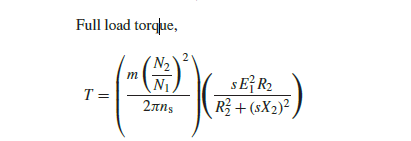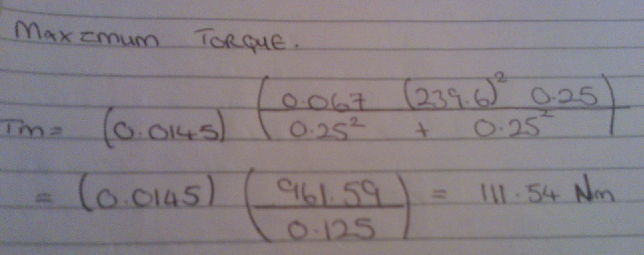evilsanta
New member
- Location
- United Kingdom
Doing my assignment for Three phase motors and one of the questions is for Torque. The assignment is due on Wednesday and I had the assignment finished ages ago but other people from my class have only just started it. One of the guys has got most of the same answers as me but then theres a change in the answers when torque is introduced so its making me second guess myself. Can someone give me some advice on it or different torque equation other than the one im using so i can double check it myself. I spent like 5 hours doing this one question because of all the maths involved in it.
A 415 V, 3 phase, 50 Hz, 4 pole star connected induction motor runs at 23 rev/s on full load. The rotor resistance and reactance per phase 0.25 ohms and 3.75 ohms respectively. The effective rotor-stator turns ratio is 0.87:1
a. Using the formula to calculate the synchronous speed:
Ns = f/p
50/2= 25 revs
b. Slip speed is calculated by the formula of:

25-23/25= 8% slip.
c. To work out the full load torque we first must work out the phase voltage:
Phase voltage, E1 =415/?3= 239.6volts
To calculate the torque:


d. To work out the power output if the mechanical losses amount to 800 W
Use Formula:

2 ? (23)(109.17)= 15777 watts
So Power output - mechanical loss = 15777-800= 14.98KW
e. the speed at which maximum torque occurs:
We first calculate the slip of the torque which you do by the formula:

s=0.25/3.75= 0.067
Formula to use to calculate maximum torque:


Maximum Torque = 111.54Nm
To get the speed when maximum torque occurs we need to use the following formula:
0.067= (25-nr/25)
(0.067)(25)= 25-nr
nr= 25-(0.067)(25) nr=23.325 rev/s or 1400 rev/min
f. the starting current use the formula:

Starting Current is 55.46A
A 415 V, 3 phase, 50 Hz, 4 pole star connected induction motor runs at 23 rev/s on full load. The rotor resistance and reactance per phase 0.25 ohms and 3.75 ohms respectively. The effective rotor-stator turns ratio is 0.87:1
a. Using the formula to calculate the synchronous speed:
Ns = f/p
50/2= 25 revs
b. Slip speed is calculated by the formula of:
25-23/25= 8% slip.
c. To work out the full load torque we first must work out the phase voltage:
Phase voltage, E1 =415/?3= 239.6volts
To calculate the torque:
d. To work out the power output if the mechanical losses amount to 800 W
Use Formula:
2 ? (23)(109.17)= 15777 watts
So Power output - mechanical loss = 15777-800= 14.98KW
e. the speed at which maximum torque occurs:
We first calculate the slip of the torque which you do by the formula:
s=0.25/3.75= 0.067
Formula to use to calculate maximum torque:
Maximum Torque = 111.54Nm
To get the speed when maximum torque occurs we need to use the following formula:
0.067= (25-nr/25)
(0.067)(25)= 25-nr
nr= 25-(0.067)(25) nr=23.325 rev/s or 1400 rev/min
f. the starting current use the formula:
Starting Current is 55.46A
